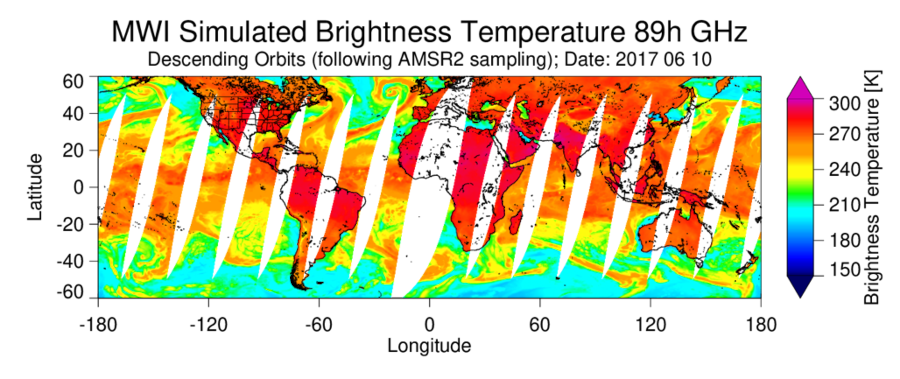EPS-SG MWI Simulated Brightness Temperatures
Dataset 1
A set of collocated GPM active microwave observations, joined by modeled atmospheric state, is used as an input to a radiative transfer model to produce MWI simulated brightness temperatures (Tbs). EPS-SG MWI channels, ranging from 18.9 GHz to 89 GHz (h- and v-polarized), are simulated using GPM DPR-observed hydrometeor profiles and ECMWF reanalysis following the MWI scanning geometry. Currently, the EPS-SG MWI proxy data are available at eight channels [18.7, 23.8, 31.4, 89 (both V- and H-polarized)], over all surface types, at MWI field of view with DPR-characteristic sampling (~5km spacing along scan line with 13km between consecutive scans) over the 66°S-66°N domain. An example showing a portion of a simulated orbit shown below.

18.7h GHZ |

18.7v GHZ |

23.8h GHZ |

23.8v GHZ |

31.4h GHZ |

31.4v GHZ |

89h GHZ |

89v GHZ |
Dataset 2
Community Radiative Transfer Model (CRTM) is used to produce MWI simulated brightness temperatures (Tbs). EPS-SG MWI channels, ranging from 18.9 GHz to 183 GHz (h- and v-polarized), are simulated using ECMWF reanalysis. Simulations use MWI scanning geometry following GCOM-W1 AMSR2 track/scan over a period of several months. The resulting product offers simulated MWI Tbs at all 26 channels and their corresponding ASMR2 geolocations. Sampling with spacing of ~5km along and between consecutive pixels and scan lines covers pole-to-pole domain. An example showing a single day of ascending orbits is shown below.

For questions and inquires please contact Dr. Veljko Petkovic at CISESS, University of Maryland (Veljko.Petkovic@umd.edu).
